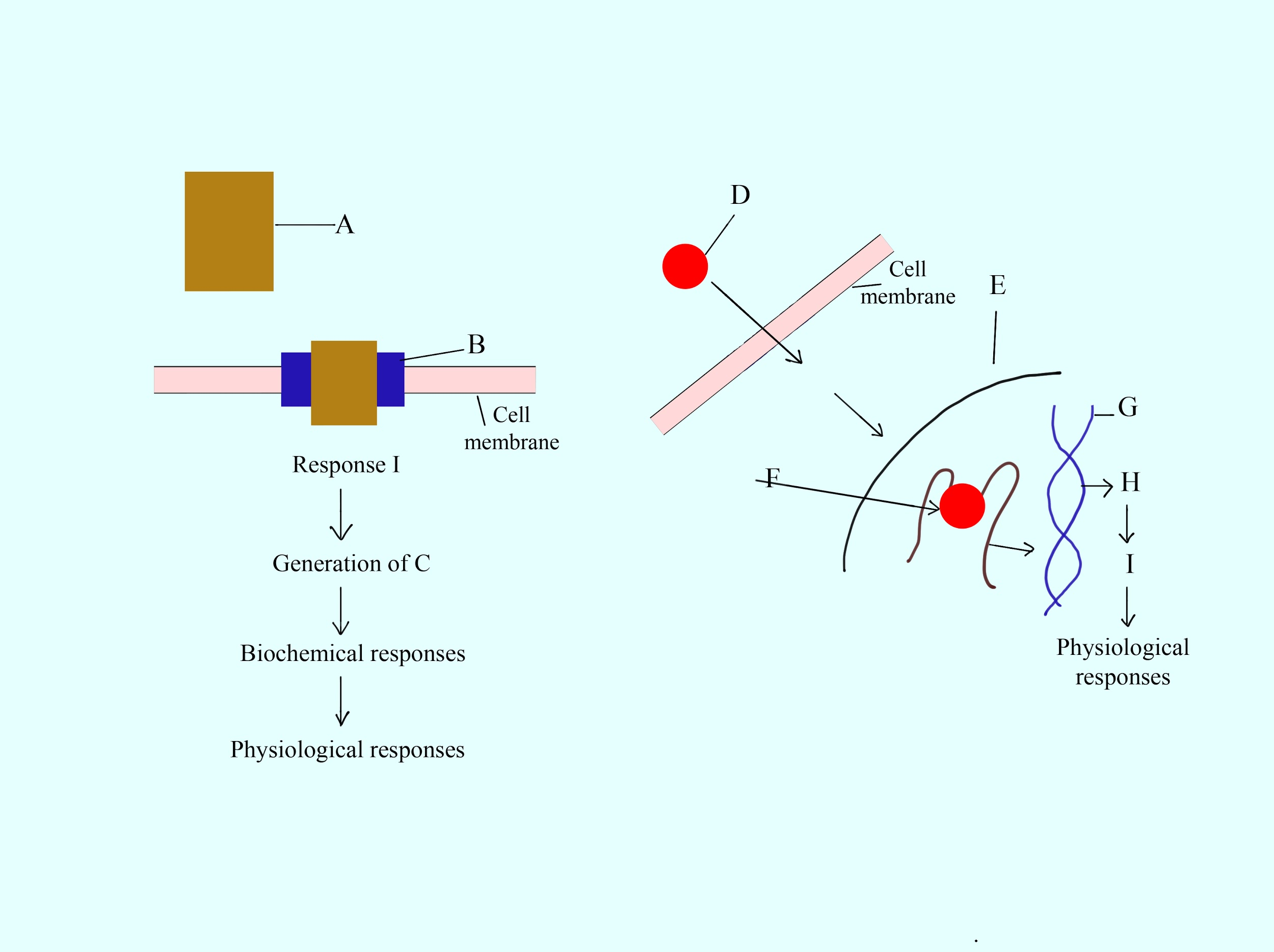
The given diagram represents the mechanism of action for two categories of hormones. Which of the following options correctly identifies the label A to I?

(a) A- Steroid hormone, B-Receptor, C-Secondary messenger, D-Non-steroid hormone, E-Nucleus, F-Hormone-receptor complex, G-Genome, H-mRNA, I-protein
(b) A- Non-Steroid hormone, B-Receptor, C-Secondary messenger, D-Steroid hormone, E-Nucleus, F-Hormone-receptor complex, G-Genome, H-mRNA, I-protein
(c) A-Steroid hormone, B-Receptor, C-primary messenger, D-Non-steroid hormone, E-Nucleus, F-Hormone-receptor complex, G-Genome, H-mRNA, I-protein
(d) A-Steroid hormone, B-enzyme, C-Secondary messenger, D-Non-steroid hormone, E-Nucleus, F-Hormone-receptor complex, G-Genome, H-mRNA, I-protein

Answer
466.5k+ views
Hint: Most of the endocrine hormones are involved in the first shown pathway and most of the sex organs are involved in the second signaling pathway shown above. The peptide hormones are polar and stored in vesicles whereas the hormones involved at the nuclear level are secreted immediately.
Complete step by step answer:
- Steroid hormones are lipids so they can easily cross the cell membrane
- Once inside, it binds to a steroid receptor protein and forms a hormone-receptor complex.
- Steroid hormones act by entering the nucleus of a cell and changing the pattern of gene expression.mRNA is produced after activating specific target genes.
- The mRNA moves into the cytoplasm and directs protein synthesis.
- Non-steroid hormones consist of amino acids that are the reason why they are not fat-soluble, and can not diffuse across the plasma membrane of target cells.
- A nonsteroid hormone binds to receptors on the cell membrane.
- The binding of the hormone activates enzymes on the inner surface of the cell membrane.
- These enzymes release secondary messengers to relay the hormone’s message within the cell.
- These secondary messengers can activate or inhibit a wide range of cell activities.
- The signaling of the non-steroid pathway is fast while the steroid signaling pathway is slow.
So, the correct answer is ‘A-Non-Steroid hormone, B-Receptor, C-Secondary messenger, D-Steroid hormone, E-Nucleus, F-Hormone-receptor complex, G-Genome, H-mRNA, I-protein.’
Note:
- Glucocorticoids, mineralocorticoids, androgens, estrogens, and progestogens are steroid hormones.
- Secondary messengers include cyclic AMP (cAMP), calcium ions, nitric oxide (NO), and protein kinases.
- The use of second messengers enables the amplification of the initial original signal.
- Peptide hormones include insulin, glucagon, leptin, ADH, and oxytocin.
Complete step by step answer:
- Steroid hormones are lipids so they can easily cross the cell membrane
- Once inside, it binds to a steroid receptor protein and forms a hormone-receptor complex.
- Steroid hormones act by entering the nucleus of a cell and changing the pattern of gene expression.mRNA is produced after activating specific target genes.
- The mRNA moves into the cytoplasm and directs protein synthesis.
- Non-steroid hormones consist of amino acids that are the reason why they are not fat-soluble, and can not diffuse across the plasma membrane of target cells.
- A nonsteroid hormone binds to receptors on the cell membrane.
- The binding of the hormone activates enzymes on the inner surface of the cell membrane.
- These enzymes release secondary messengers to relay the hormone’s message within the cell.
- These secondary messengers can activate or inhibit a wide range of cell activities.
- The signaling of the non-steroid pathway is fast while the steroid signaling pathway is slow.
So, the correct answer is ‘A-Non-Steroid hormone, B-Receptor, C-Secondary messenger, D-Steroid hormone, E-Nucleus, F-Hormone-receptor complex, G-Genome, H-mRNA, I-protein.’
Note:
- Glucocorticoids, mineralocorticoids, androgens, estrogens, and progestogens are steroid hormones.
- Secondary messengers include cyclic AMP (cAMP), calcium ions, nitric oxide (NO), and protein kinases.
- The use of second messengers enables the amplification of the initial original signal.
- Peptide hormones include insulin, glucagon, leptin, ADH, and oxytocin.
Recently Updated Pages
The correct geometry and hybridization for XeF4 are class 11 chemistry CBSE

Water softening by Clarks process uses ACalcium bicarbonate class 11 chemistry CBSE

With reference to graphite and diamond which of the class 11 chemistry CBSE

A certain household has consumed 250 units of energy class 11 physics CBSE

The lightest metal known is A beryllium B lithium C class 11 chemistry CBSE

What is the formula mass of the iodine molecule class 11 chemistry CBSE

Trending doubts
The reservoir of dam is called Govind Sagar A Jayakwadi class 11 social science CBSE

What problem did Carter face when he reached the mummy class 11 english CBSE

Proton was discovered by A Thomson B Rutherford C Chadwick class 11 chemistry CBSE

In China rose the flowers are A Zygomorphic epigynous class 11 biology CBSE

What is Environment class 11 chemistry CBSE

Nucleolus is present in which part of the cell class 11 biology CBSE




